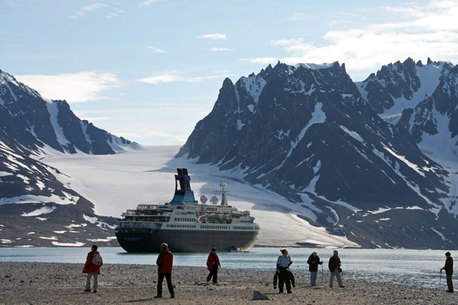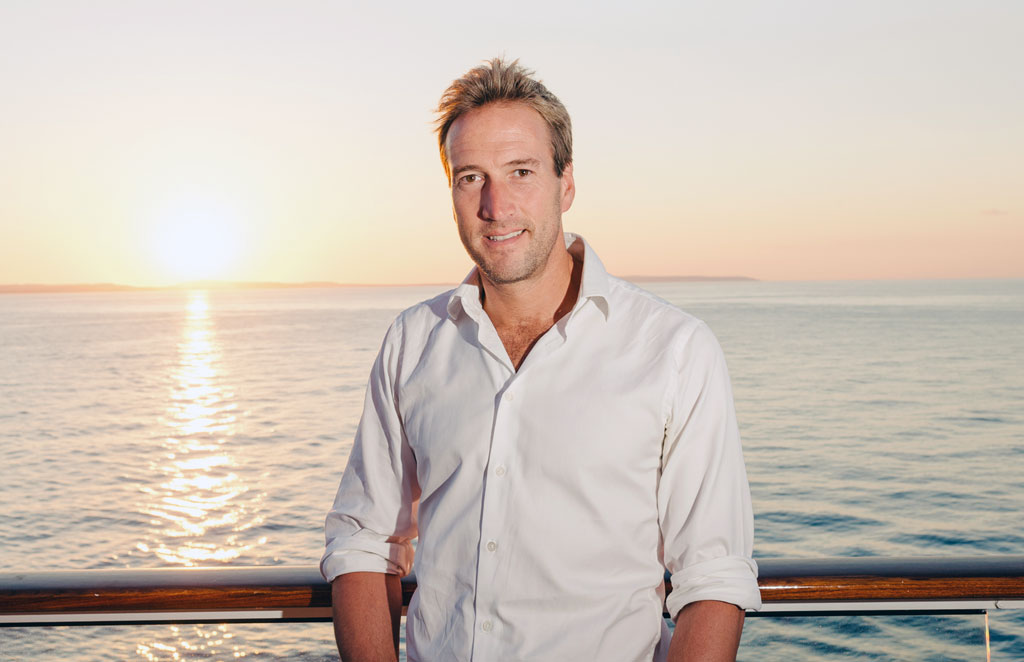 Quest for Adventure in Magdalena Bay, Svalbard
Quest for Adventure in Magdalena Bay, Svalbard
It’s a bit like boarding a plane. Most people turn right when they step from the air bridge and through the doorway; only a privileged few turn left.
With cruise ships, the majority turn right when they leave Southampton or Dover, heading for the Mediterranean or the Canaries. A few turn left, to spend the next few days in the Baltic or the fjords, and in the case of Quest for Adventure this week, even further afield.
After a sprint up the Norwegian coast, calling at busy Stavanger, serene Brønnøysund, and remote Leknes in the Lofoten Islands, the ship set a course due north for the wilderness that is Svalbard.
We had two full days at sea, with experienced naturalists from ORCA on hand to identify the varied birds, dolphins and whales spotted en route – including a surprising number of blue whales.
 Modern homes and coalmining relics in Longyearbyen, Svalbard
Modern homes and coalmining relics in Longyearbyen, Svalbard
Then we reached Longyearbyen, largest and oldest settlement on Spitsbergen, itself the biggest island in the group. To call it the capital city would be stretching things – it hardly even ranks as a town.
Founded just over 100 years ago when American engineer John Munroe Longyear opened the first of several coalmines, it remained a raw frontier barracks for decades.
Only in recent years, with the decline of mining, has it developed into a home for families and a welcoming base for intrepid tourists prepared to brave its brutal climate.

 Quest’s intrepid adventurers set out on sightseeing tours, a hike to a glacier, and to dogsledding trips – their husky-hauled sleds on wheels rather than runners. While the dogs are a picturesque form of transport for the 2,500 residents, most prefer rugged 4×4 pick-ups in the brief summer and powerful snowmobiles the rest of the year. There are more skidoos than people, although at the moment they lie forlorn in the car parks and fields, leaving the reindeer and arctic foxes undisturbed.
Quest’s intrepid adventurers set out on sightseeing tours, a hike to a glacier, and to dogsledding trips – their husky-hauled sleds on wheels rather than runners. While the dogs are a picturesque form of transport for the 2,500 residents, most prefer rugged 4×4 pick-ups in the brief summer and powerful snowmobiles the rest of the year. There are more skidoos than people, although at the moment they lie forlorn in the car parks and fields, leaving the reindeer and arctic foxes undisturbed.
 Railway relics in Ny-Ålesund, Svalbard
Railway relics in Ny-Ålesund, Svalbard
Next stop was Ny-Ålesund, which claims to be the world’s most northerly permanent settlement. During the summer it is home to about 200 scientists from China, Great Britain, Italy, India, Japan, Norway, South Korea and the US. Fewer than 50 intrepid souls remain during the winter to continue research into meteorology and climate change, the Northern Light, glaciology and botany.
Passengers going ashore were instructed to keep to the few roads in the town; the marshals from the ship’s crew whose job it was to prevent us straying were hardly needed because aggressive Arctic Terns flew in to dive-bomb anyone stepping too far into the tundra.
At the end of the permitted road stood a ranger armed with a rifle, ready to repel any polar bears that might come too close.
 Tern again: Aggressive birds let you know you’re not welcome
Tern again: Aggressive birds let you know you’re not welcome
Our final port of call in Svalbard was Magdalena Bay, a narrow inlet hemmed in with jagged mountain peaks, between which vivid blue glaciers made their unstoppable progress to the sea.
There’s no houses, shops or cafés in this desolate spot. Just a lonely cabin and an idyllic beach, on which our crew set up a temporary landing stage and the world’s most northerly bar, serving hot chocolate, fruit juice and glühwein.
 First to the bar, as far north as you can get
First to the bar, as far north as you can get
No more than 100 passengers were allowed ashore at any one time and there were gloriously blue skies overhead as the first boatload made the short crossing, dodging ice floes from the glaciers.
We avoided more terns to take a look at a fenced-off cemetery area which was the final resting place for fishermen and whalers – many of them British – during the 17th and 18th Centuries. Further along the beach are the remains of ovens where whale blubber was rendered down to make oil.
Once again we were restricted to a small area of beach. The two rangers who had accompanied us north claimed to have seen recent polar bear paw-prints in the sand. But there was no chance we would see one, was there?
The early bird passengers had returned to the ship for breakfast and were relaxing on deck. The Orca team were keeping watch for birds and seals – they had earlier spotted two walrus on the way into the bay.
Suddenly there was a stir at the aft of the ship. Someone had spotted a polar bear. It was pacing determinedly along the shingle spit leading to the beach. Heading right for the passengers who were sipping their drinks completely unconcerned.
It became apparent the bear had escaped the attention of the rangers. Passengers debated whether to tell the bridge or take advantage of the photo-opportunity.
Valour, and a desire to avoid bloodshed, won the day. A message was radioed ashore and while a ranger set off to fire flares intended to scare off the bear without doing it any harm our fellow passengers were herded back onto the tender.
There were fewer than 100 people on the beach at the time of the bear’s appearance; by the time cocktail hour came round in the evening there were more than 400 relating their escape from almost-certain death.
But that’s Saga’s adventure cruisers for you. Prepared to travel almost to the ends of the earth – in considerable comfort – and living to tell the tale.
 Magnificent creature: Our polar bear encounter on the beach
Magnificent creature: Our polar bear encounter on the beach






Leave A Comment